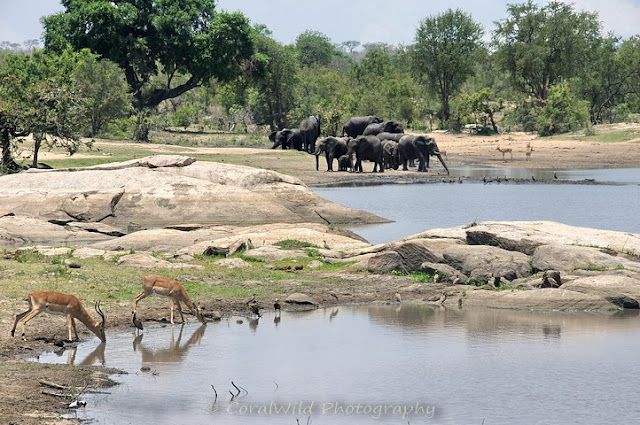 | |
| Sunset over the Great Escarpment and the Valley of the Olifants |
It's been a really good re-introduction to safari life and a great reminder of why I love this work so much.
Looking over my photos from the last 3 months I also realised how quickly and dramatically the bush changes from the scorched earth of spring and the drawn out end of the dry season, to the lush green vegetation that seems to appear so abruptly once the rains arrive.
This year, the rains delayed and delayed, but since arriving in late December, they have made up for lost time with endless grey, drizzly days interspersed by frequent deluges.
These photos are some of my favourites of the last 3 months and also show quite clearly the transition from dry to wet..........
Mid October

When we went out on our first afternoon game drive in the Balule, these lions were still chewing on a baby giraffe they had killed much earlier that day.

After dark the cubs were allowed onto the carcase, and once their bellies were full they thirstily gulped water from the nearby waterhole.
Other highlights from our October safari......
 |
| The rare Black Rhino - not much nourishing green in that mouthful |
 |
| Displaying a little aggression on approaching the lodge waterhole |
 |
| My best photo ever of a Steenbok |
 |
| Black-backed Jackal |
 |
| A stately Waterbuck |
November
 |
| Pied Kingfisher |
 | |
| An amazingly close encounter with a Verreaux Eagle-Owl |
Kruger does have some evergreen vegetation, trees that grow on the riverbanks or in wetter areas, giving these birds that lovely green backdrop.
By the end of the dry season one can see the river courses from quite a distance away, the only green visible in thousands of square kilometres.
 Much to the relief of the browsers (giraffe, kudu etc.) Kruger's acacia trees start coming out in their spring leaf well before the rains arrive.
Much to the relief of the browsers (giraffe, kudu etc.) Kruger's acacia trees start coming out in their spring leaf well before the rains arrive.
For me it's always a slightly bizarre sight - dry, sun-bleached veld dotted with the vibrant spring green of the acacias.
 |
| A multitude of different animals at Transport Dam |
By the end of November there had been a few days with scattered thunder showers - just enough to get a sprinkling of green grass in some areas, but the large waterholes were still the only places the wildlife could drink. (there were also buffalo and rhino at this waterhole)
January
And after just a couple of weeks of rain...........
 |
| Lots of babies around by mid-summer |
 |
| This bull elephant was enjoying the lush green grass around & under the bushes |
After a night of exceptionally heavy rain, this leopard mother had just caught an impala and was watching her cub enjoy it's meal.


6 comments:
Oh, Sue, this makes me so nostalgic - what wonderful memories it evokes.
Your photo of the Steenbok put a large smile on my face.
Happy New Year!
xDiana.
I sure like seeing the wildlife yet it seems so different than when I've been there in January and February.
Having grown up in Africa, but no longer living there, thank you, Sue, for beautifully composed, well-defined portraits of African wildlife. They speak for themselves, while you provide their context with the knowledge and care of an expert curator. Your work helps them face the challenge of being "out of sight, out of mind" and towards their conservation.
Hi Gaelyn, the rains were really late this year so the grass is still short. It can become a lot harder to find the animals once the grass gets longer....
Thanks Mark !
Hi Sue - brilliant photos ... just took me over and down south - gloomy and perhaps about to snow here - loved seeing the shots - Have a great 2019 - cheers Hilary
Post a Comment